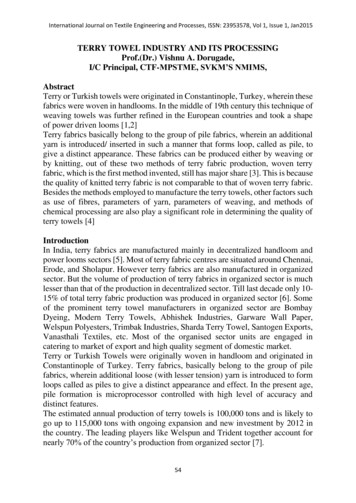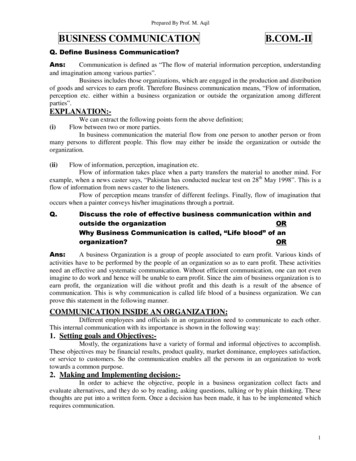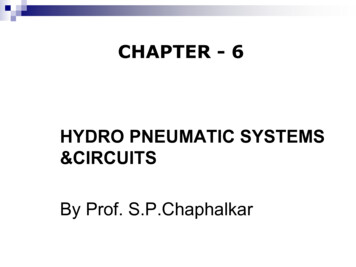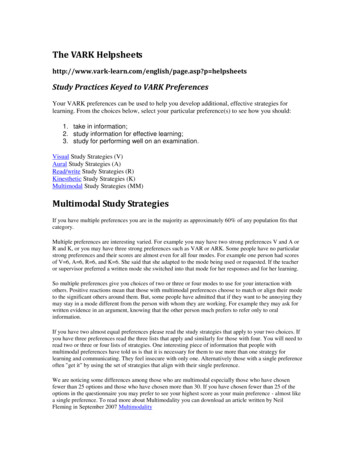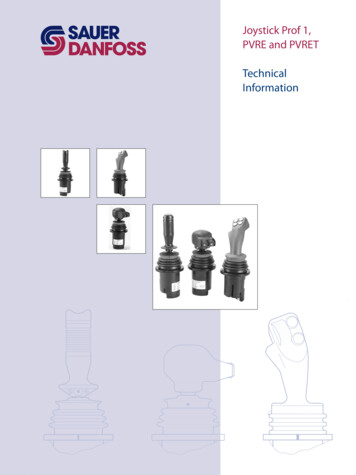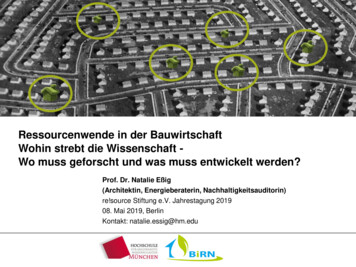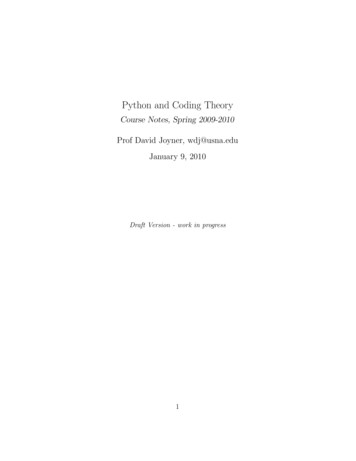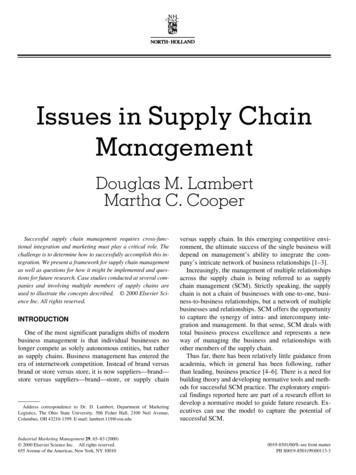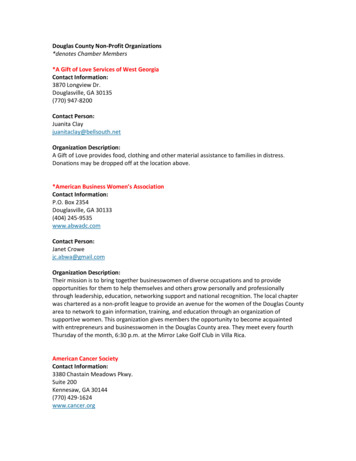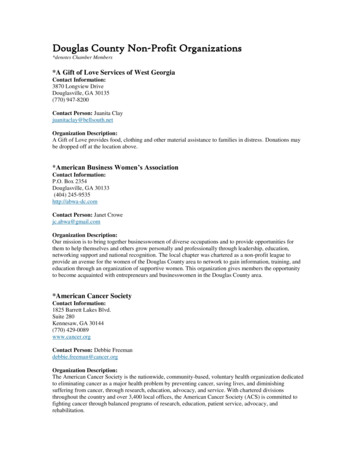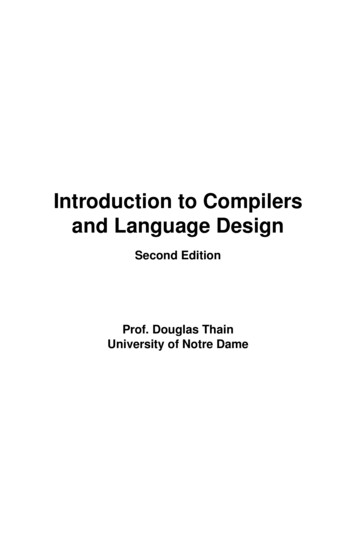
Transcription
Introduction to Compilersand Language DesignSecond EditionProf. Douglas ThainUniversity of Notre Dame
Introduction to Compilers and Language DesignCopyright 2020 Douglas Thain.Paperback ISBN: 979-8-655-18026-0Second edition.Anyone is free to download and print the PDF edition of this book for personal use. Commercial distribution, printing, or reproduction without theauthor’s consent is expressly prohibited. All other rights are reserved.You can find the latest version of the PDF edition, and purchase inexpensive hardcover copies at http://compilerbook.orgRevision Date: January 28, 2022
iiiFor Lisa, William, Zachary, Emily, and Alia.iii
iviv
vContributionsI am grateful to the following people for their contributions to this book:Andrew Litteken drafted the chapter on ARM assembly; Kevin Latimerdrew the RegEx to NFA and the LR example figures; Benjamin Gunningfixed an error in LL(1) parse table construction; Tim Shaffer completed thedetailed LR(1) example.And the following people corrected typos:Sakib Haque (27), John Westhoff (26), Emily Strout (26), Gonzalo Martinez(25), Daniel Kerrigan (24), Brian DuSell (23), Ryan Mackey (20), TJ Dasso(18), Nedim Mininovic (15), Noah Yoshida (14), Joseph Kimlinger (12),Nolan McShea (11), Jongsuh Lee (11), Kyle Weingartner (10), Andrew Litteken (9), Thomas Cane (9), Samuel Battalio (9), Stéphane Massou (8), LuisPrieb (7), William Diederich (7), Jonathan Xu (6), Gavin Inglis (6), Kathleen Capella (6), Edward Atkinson (6), Tanner Juedeman (5), John Johnson(4), Luke Siela (4), Francis Schickel (4), Eamon Marmion (3), Molly Zachlin(3), David Chiang (3), Jacob Mazur (3), Spencer King (2), Yaoxian Qu (2),Maria Aranguren (2), Patrick Lacher (2), Connor Higgins (2), Tango Gu (2),Andrew Syrmakesis (2), Horst von Brand (2), John Fox (2), Jamie Zhang(2), Benjamin Gunning (1) Charles Osborne (1), William Theisen (1), Jessica Cioffi (1), Ben Tovar (1), Ryan Michalec (1), Patrick Flynn (1), ClintJeffery (1), Ralph Siemsen (1), John Quinn (1), Paul Brunts (1), Luke Wurl(1), Bruce Mardle (1), Dane Williams (1), Thomas Fisher (1), Alan Johnson(1), Jacob Harris (1), Jeff Clinton (1), Reto Habluetzel (1), Chris Fietkiewicz(1)Please send any comments or corrections via email to Prof. DouglasThain (dthain@nd.edu).v
vivi
CONTENTSviiContents1234Introduction1.1 What is a compiler? . . . . . . . . . . . . . . . .1.2 Why should you study compilers? . . . . . . .1.3 What’s the best way to learn about compilers?1.4 What language should I use? . . . . . . . . . .1.5 How is this book different from others? . . . .1.6 What other books should I read? . . . . . . . .A Quick Tour2.1 The Compiler Toolchain .2.2 Stages Within a Compiler2.3 Example Compilation . . .2.4 Exercises . . . . . . . . . .1122234.556710Scanning3.1 Kinds of Tokens . . . . . . . . . . . . . . .3.2 A Hand-Made Scanner . . . . . . . . . . .3.3 Regular Expressions . . . . . . . . . . . .3.4 Finite Automata . . . . . . . . . . . . . . .3.4.1 Deterministic Finite Automata . .3.4.2 Nondeterministic Finite Automata3.5 Conversion Algorithms . . . . . . . . . . .3.5.1 Converting REs to NFAs . . . . . .3.5.2 Converting NFAs to DFAs . . . . .3.5.3 Minimizing DFAs . . . . . . . . . .3.6 Limits of Finite Automata . . . . . . . . .3.7 Using a Scanner Generator . . . . . . . . .3.8 Practical Considerations . . . . . . . . . .3.9 Exercises . . . . . . . . . . . . . . . . . . .3.10 Further Reading . . . . . . . . . . . . . . .11111213151617191922242626283133Parsing4.1 Overview . . . . . . . . . . . . . . . . . . . . . . . . . . . . . .4.2 Context Free Grammars . . . . . . . . . . . . . . . . . . . . .353536.vii.
viiiCONTENTS4.34.44.54.64.74.85674.2.1 Deriving Sentences . . . . . . . . .4.2.2 Ambiguous Grammars . . . . . . .LL Grammars . . . . . . . . . . . . . . . .4.3.1 Eliminating Left Recursion . . . .4.3.2 Eliminating Common Left Prefixes4.3.3 First and Follow Sets . . . . . . . .4.3.4 Recursive Descent Parsing . . . . .4.3.5 Table Driven Parsing . . . . . . . .LR Grammars . . . . . . . . . . . . . . . .4.4.1 Shift-Reduce Parsing . . . . . . . .4.4.2 The LR(0) Automaton . . . . . . .4.4.3 SLR Parsing . . . . . . . . . . . . .4.4.4 LR(1) Parsing . . . . . . . . . . . .4.4.5 LALR Parsing . . . . . . . . . . . .Grammar Classes Revisited . . . . . . . .The Chomsky Hierarchy . . . . . . . . . .Exercises . . . . . . . . . . . . . . . . . . .Further Reading . . . . . . . . . . . . . . .373840414243454749505155596262636567Parsing in Practice5.1 The Bison Parser Generator5.2 Expression Validator . . . .5.3 Expression Interpreter . . .5.4 Expression Trees . . . . . . .5.5 Exercises . . . . . . . . . . .5.6 Further Reading . . . . . . .69707374758183The Abstract Syntax Tree6.1 Overview . . . . . . . .6.2 Declarations . . . . . .6.3 Statements . . . . . . .6.4 Expressions . . . . . .6.5 Types . . . . . . . . . .6.6 Putting it All Together6.7 Building the AST . . .6.8 Exercises . . . . . . . .858586889092959698Semantic Analysis7.1 Overview of Type Systems . .7.2 Designing a Type System . . .7.3 The B-Minor Type System . .7.4 The Symbol Table . . . . . . .7.5 Name Resolution . . . . . . .7.6 Implementing Type Checking7.7 Error Messages . . . . . . . .99100103106107111113117.viii
CONTENTS7.87.98ixExercises . . . . . . . . . . . . . . . . . . . . . . . . . . . . . . 118Further Reading . . . . . . . . . . . . . . . . . . . . . . . . . . 118Intermediate Representations8.1 Introduction . . . . . . . . . . . . . . . . . . . .8.2 Abstract Syntax Tree . . . . . . . . . . . . . . .8.3 Directed Acyclic Graph . . . . . . . . . . . . . .8.4 Control Flow Graph . . . . . . . . . . . . . . . .8.5 Static Single Assignment Form . . . . . . . . .8.6 Linear IR . . . . . . . . . . . . . . . . . . . . . .8.7 Stack Machine IR . . . . . . . . . . . . . . . . .8.8 Examples . . . . . . . . . . . . . . . . . . . . . .8.8.1 GIMPLE - GNU Simple Representation8.8.2 LLVM - Low Level Virtual Machine . .8.8.3 JVM - Java Virtual Machine . . . . . . .8.9 Exercises . . . . . . . . . . . . . . . . . . . . . .8.10 Further Reading . . . . . . . . . . . . . . . . . .119119119120125127128129130130131132133134Memory Organization9.1 Introduction . . . . . . . . . . . . . .9.2 Logical Segmentation . . . . . . . . .9.3 Heap Management . . . . . . . . . .9.4 Stack Management . . . . . . . . . .9.4.1 Stack Calling Convention . .9.4.2 Register Calling Convention9.5 Locating Data . . . . . . . . . . . . .9.6 Program Loading . . . . . . . . . . .9.7 Further Reading . . . . . . . . . . . .13513513513814014114214314614810 Assembly Language10.1 Introduction . . . . . . . . . . . . . .10.2 Open Source Assembler Tools . . . .10.3 X86 Assembly Language . . . . . . .10.3.1 Registers and Data Types . .10.3.2 Addressing Modes . . . . . .10.3.3 Basic Arithmetic . . . . . . .10.3.4 Comparisons and Jumps . . .10.3.5 The Stack . . . . . . . . . . .10.3.6 Calling a Function . . . . . .10.3.7 Defining a Leaf Function . . .10.3.8 Defining a Complex Function10.4 ARM Assembly . . . . . . . . . . . .10.4.1 Registers and Data Types . .10.4.2 Addressing Modes . . . . . .10.4.3 Basic Arithmetic . . . . . . ix
xCONTENTS10.4.4 Comparisons and Branches .10.4.5 The Stack . . . . . . . . . . .10.4.6 Calling a Function . . . . . .10.4.7 Defining a Leaf Function . . .10.4.8 Defining a Complex Function10.4.9 64-bit Differences . . . . . . .10.5 Further Reading . . . . . . . . . . . .171173174175176179180.18118118118318819219319412 Optimization12.1 Overview . . . . . . . . . . . . . . . . . . . . .12.2 Optimization in Perspective . . . . . . . . . .12.3 High Level Optimizations . . . . . . . . . . .12.3.1 Constant Folding . . . . . . . . . . . .12.3.2 Strength Reduction . . . . . . . . . . .12.3.3 Loop Unrolling . . . . . . . . . . . . .12.3.4 Code Hoisting . . . . . . . . . . . . . .12.3.5 Function Inlining . . . . . . . . . . . .12.3.6 Dead Code Detection and Elimination12.4 Low-Level Optimizations . . . . . . . . . . .12.4.1 Peephole Optimizations . . . . . . . .12.4.2 Instruction Selection . . . . . . . . . .12.5 Register Allocation . . . . . . . . . . . . . . .12.5.1 Safety of Register Allocation . . . . .12.5.2 Priority of Register Allocation . . . . .12.5.3 Conflicts Between Variables . . . . . .12.5.4 Global Register Allocation . . . . . . .12.6 Optimization Pitfalls . . . . . . . . . . . . . .12.7 Optimization Interactions . . . . . . . . . . .12.8 Exercises . . . . . . . . . . . . . . . . . . . . .12.9 Further Reading . . . . . . . . . . . . . . . . 09210211212214215A Sample Course ProjectA.1 Scanner Assignment . . .A.2 Parser Assignment . . . .A.3 Pretty-Printer AssignmentA.4 Typechecker Assignment .21721721721821811 Code Generation11.1 Introduction . . . . . . .11.2 Supporting Functions . .11.3 Generating Expressions11.4 Generating Statements .11.5 Conditional Expressions11.6 Generating Declarations11.7 Exercises . . . . . . . . .x.
CONTENTSxiA.5 Optional: Intermediate Representation . . . . . . . . . . . . . 218A.6 Code Generator Assignment . . . . . . . . . . . . . . . . . . . 218A.7 Optional: Extend the Language . . . . . . . . . . . . . . . . . 219B The B-Minor LanguageB.1 Overview . . . . . . . . . . .B.2 Tokens . . . . . . . . . . . .B.3 Types . . . . . . . . . . . . .B.4 Expressions . . . . . . . . .B.5 Declarations and StatementsB.6 Functions . . . . . . . . . . .B.7 Optional Elements . . . . .221221222222223224224225C Coding Conventions227Index229xi
xiiCONTENTSxii
LIST OF FIGURESxiiiList of Figures2.12.22.32.42.5A Typical Compiler Toolchain . . . . .The Stages of a Unix Compiler . . . .Example AST . . . . . . . . . . . . . .Example Intermediate RepresentationExample Assembly Code . . . . . . . .5699103.13.23.33.43.53.63.73.83.93.10A Simple Hand Made Scanner . . . . . . . . . . . . . .Relationship Between REs, NFAs, and DFAs . . . . .Subset Construction Algorithm . . . . . . . . . . . . .Converting an NFA to a DFA via Subset ConstructionHopcroft’s DFA Minimization Algorithm . . . . . . .Structure of a Flex File . . . . . . . . . . . . . . . . . .Example Flex Specification . . . . . . . . . . . . . . . .Example Main Program . . . . . . . . . . . . . . . . .Example Token Enumeration . . . . . . . . . . . . . .Build Procedure for a Flex Program . . . . . . . . . . .121922232427292930304.14.24.34.44.54.64.7Two Derivations of the Same Sentence . . .A Recursive-Descent Parser . . . . . . . . .LR(0) Automaton for Grammar G10 . . . .SLR Parse Table for Grammar G10 . . . . .Part of LR(0) Automaton for Grammar G11LR(1) Automaton for Grammar G10 . . . .The Chomsky Hierarchy . . . . . . . . . . .384653565861645.15.25.35.45.55.65.75.8Bison Specification for Expression Validator . .Main Program for Expression Validator . . . .Build Procedure for Bison and Flex Together .Bison Specification for an Interpreter . . . . . .AST for Expression Interpreter . . . . . . . . .Building an AST for the Expression Grammar .Evaluating Expressions . . . . . . . . . . . . . .Printing and Evaluating Expressions . . . . . .71727275767880817.1The Symbol Structure . . . . . . . . . . . . . . . . . . . . . . . 107xiii.
xivLIST OF FIGURES7.27.37.47.5A Nested Symbol Table . . . . . . .Symbol Table API . . . . . . . . . .Name Resolution for DeclarationsName Resolution for Expressions .1091101121128.18.28.3Sample DAG Data Structure Definition . . . . . . . . . . . . 120Example of Constant Folding . . . . . . . . . . . . . . . . . . 125Example Control Flow Graph . . . . . . . . . . . . . . . . . . 1269.19.29.3Flat Memory Model . . . . . . . . . . . . . . . . . . . . . . . . 135Logical Segments . . . . . . . . . . . . . . . . . . . . . . . . . 136Multiprogrammed Memory Layout . . . . . . . . . . . . . . 13710.1 X86 Register Structure . . . . . . . . . . . . . .10.2 X86 Register Structure . . . . . . . . . . . . . .10.3 Summary of System V ABI Calling Convention10.4 System V ABI Register Assignments . . . . . .10.5 Example X86-64 Stack Layout . . . . . . . . . .10.6 Complete X86 Example . . . . . . . . . . . . . .10.7 ARM Addressing Modes . . . . . . . . . . . . .10.8 ARM Branch Instructions . . . . . . . . . . . .10.9 Summary of ARM Calling Convention . . . . .10.10ARM Register Assignments . . . . . . . . . . .10.11Example ARM Stack Frame . . . . . . . . . . .10.12Complete ARM Example . . . . . . . . . . . . 1.411.5Code Generation Functions . . . . . . . . . . .Example of Generating X86 Code from a DAGExpression Generation Skeleton . . . . . . . . .Generating Code for a Function Call . . . . . .Statement Generator Skeleton . . . . . . . . . .18218418618718812.112.212.312.412.512.6Timing a Fast Operation . . . . . . . . . .Constant Folding Pseudo-Code . . . . . .Example X86 Instruction Templates . . . .Example of Tree Rewriting . . . . . . . . .Live Ranges and Register Conflict GraphExample of Global Register Allocation . .197198206207210211xiv.
1Chapter 1 – Introduction1.1What is a compiler?A compiler translates a program in a source language to a program ina target language. The most well known form of a compiler is one thattranslates a high level language like C into the native assembly languageof a machine so that it can be executed. And of course there are compilersfor other languages like C , Java, C#, and Rust, and many others.The same techniques used in a traditional compiler are also used inany kind of program that processes a language. For example, a typesetting program like TEX translates a manuscript into a Postscript document.A graph-layout program like Dot consumes a list of nodes and edges andarranges them on a screen. A web browser translates an HTML documentinto an interactive graphical display. To write programs like these, youneed to understand and use the same techniques as in traditional compilers.Compilers exist not only to translate programs, but also to improve them.A compiler assists a programmer by finding errors in a program at compiletime, so that the user does not have to encounter them at runtime. Usually,a more strict language results in more compile-time errors. This makes theprogrammer’s job harder, but makes it more likely that the program iscorrect. For example, the Ada language is infamous among programmersas challenging to write without compile-time errors, but once working, istrusted to run safety-critical systems such as the Boeing 777 aircraft.A compiler is distinct from an interpreter, which reads in a programand then executes it directly, without emitting a translation. This is alsosometimes known as a virtual machine. Languages like Python and Rubyare typically executed by an interpreter that reads the source code directly.Compilers and interpreters are closely related, and it is sometimes possible to exchange one for the other. For example, Java compilers translateJava source code into Java bytecode, which is an abstract form of assembly language. Some implementations of the Java Virtual Machine work asinterpreters that execute one instruction at a time. Others work by translating the bytecode into local machine code, and then running the machinecode directly. This is known as just in time compiling or JIT.1
21.2CHAPTER 1. INTRODUCTIONWhy should you study compilers?You will be a better programmer. A great craftsman must understand hisor her tools, and a programmer is no different. By understanding moredeeply how a compiler translates your program into machine language,you will become more skilled at writing effective code and debugging itwhen things go wrong.You can create tools for debugging and translating. If you can write a parserfor a given language, then you can write all manner of supporting toolsthat help you (and others) debug your own programs. An integrated development environment like Eclipse incorporates parsers for languageslike Java, so that it can highlight syntax, find errors without compiling,and connect code to documentation as you write.You can create new languages. A surprising number of problems aremade easier by expressing them compactly in a custom language. (Theseare sometimes known as domain specific languages or simply little languages.) By learning the techniques of compilers, you will be able to implement little languages and avoid some pitfalls of language design.You can contribute to existing compilers. While it’s unlikely that you willwrite the next great C compiler (since we already have several), languageand compiler development does not stand still. Standards developmentresults in new language features; optimization research creates new waysof improving programs; new microprocessors are created; new operatingsystems are developed; and so on. All of these developments require thecontinuous improvement of existing compilers.You will have fun while solving challenging problems. Isn’t that enough?1.3What’s the best way to learn about compilers?The best way to learn about compilers is to write your own compiler frombeginning to end. While that may sound daunting at first, you will findthat this complex task can be broken down into several stages of moderate complexity. The typical undergraduate computer science student canwrite a complete compiler for a simple language in a semester, brokendown into four or five independent stages.1.4What language should I use?Without question, you should use the C programming language and theX86 assembly language, of course!Ok, maybe the answer isn’t quite that simple. There is an ever-increasingnumber of programming languages that all have different strengths andweaknesses. Java is simple, consistent, and portable, albeit not high performance. Python is easy to learn and has great library support, but isweakly typed. Rust offers exceptional static type-safety, but is not (yet)2
1.5. HOW IS THIS BOOK DIFFERENT FROM OTHERS?3widely used. It is quite possible to write a compiler in nearly any language, and you could use this book as a guide to do so.However, we really think that you should learn C, write a compiler inC, and use it to compile a C-like language which produces assembly for awidely-used processor, like X86 or ARM. Why? Because it is important foryou to learn the ins and outs of technologies that are in wide use, and notjust those that are abstractly beautiful.C is the most widely-used portable language for low-level coding (compilers, and libraries, and kernels) and it is also small enough that onecan learn how to compile every aspect of C in a single semester. True, Cpresents some challenges related to type safety and pointer use, but theseare manageable for a project the size of a compiler. There are other languages with different virtues, but none as simple and as widely used as C.Once you write a C compiler, then you are free to design your own (better)language.Likewise, the X86 has been the most widely-deployed computer architecture in desktops, servers, and laptops for several decades. While it isconsiderably more complex than other architectures like MIPS or SPARCor ARM, one can quickly learn the essential subset of instructions necessary to build a compiler. Of course, ARM is quickly catching up as apopular architecture in the mobile, embedded, and low power space, sowe have included a section on that as well.That said, the principles presented in this book are widely applicable.If you are using this as part of a class, your instructor may very well choosea different compilation language and different target assembly, and that’sfine too.1.5How is this book different from others?Most books on compilers are very heavy on the abstract theory of scanners, parsers, type systems, and register allocation, and rather light onhow the design of a language affects the compiler and the runtime. Mostare designed for use by a graduate survey of optimization techniques.This book takes a broader approach by giving a lighter dose of optimization, and introducing more material on the process of engineering acompiler, the tradeoffs in language design, and considerations for interpretation and translation.You will also notice that this book doesn’t contain a whole bunch offiddly paper-and-pencil assignments to test your knowledge of compileralgorithms. (Ok, there are a few of those in Chapters 3 and 4.) If you wantto test your knowledge, then write some working code. To that end, theexercises at the end of each chapter ask you to take the ideas in the chapter,and either explore some existing compilers, or write parts of your own. Ifyou do all of them in order, you will end up with a working compiler,summarized in the final appendix.3
41.6CHAPTER 1. INTRODUCTIONWhat other books should I read?For general reference on compilers, I suggest the following books: Charles N. Fischer, Ron K. Cytron, and Richard J. LeBlanc Jr, “Crafting a Compiler”, Pearson, 2009.This is an excellent undergraduate textbook which focuses on object-oriented software engineering techniques for constructing a compiler, with a focus on generatingoutput for the Java Virtual Machine. Christopher Fraser and David Hanson, “A Retargetable C Compiler: Design and Implementation”, Benjamin/Cummings, 1995.Also known as the “LCC book”, this book focuses entirely on explaining the C implementation of a C compiler by taking the unusual approach of embedding the literalcode into the textbook, so that code and explanation are intertwined. Alfred V. Aho, Monica S. Lam, Ravi Sethi, and Jeffrey D. Ullman,“Compilers: Principles, Techniques, and Tools”, Addison Wesley,2006. Affectionately known as the “dragon book”, this is a comprehensive treatment of the theory of compilers from scanning through type theory and optimizationat an advanced graduate level.Ok, what are you waiting for? Let’s get to work.4
5Chapter 2 – A Quick Tour2.1The Compiler ToolchainA compiler is one component in a toolchain of programs used to createexecutables from source code. Typically, when you invoke a single command to compile a program, a whole sequence of programs are invoked inthe background. Figure 2.1 shows the programs typically used in a Unixsystem for compiling C source code to assembly ssembler(as)Object utable(prog)Dynamic )Figure 2.1: A Typical Compiler Toolchain The preprocessor prepares the source code for the compiler proper.In the C and C languages, this means consuming all directives thatstart with the # symbol. For example, an #include directive causesthe preprocessor to open the named file and insert its contents intothe source code. A #define directive causes the preprocessor tosubstitute a value wherever a macro name is encountered. (Not alllanguages rely on a preprocessor.) The compiler proper consumes the clean output of the preprocessor. It scans and parses the source code, performs typechecking and5
6CHAPTER 2. A QUICK TOURother semantic routines, optimizes the code, and then produces assembly language as the output. This part of the toolchain is the mainfocus of this book. The assembler consumes the assembly code and produces objectcode. Object code is “almost executable” in that it contains raw machine language instructions in the form needed by the CPU. However, object code does not know the final memory addresses in whichit will be loaded, and so it contains gaps that must be filled in by thelinker. The linker consumes one or more object files and library files andcombines them into a complete, executable program. It selects thefinal memory locations where each piece of code and data will beloaded, and then “links” them together by writing in the missing address information. For example, an object file that calls the printffunction does not initially know the address of the function. Anempty (zero) address will be left where the address must be used.Once the linker selects the memory location of printf, it must goback and write in the address at every place where printf is called.In Unix-like operating systems, the preprocessor, compiler, assembler,and linker are historically named cpp, cc1, as, and ld respectively. Theuser-visible program cc simply invokes each element of the toolchain inorder to produce the final executable.2.2Stages Within a CompilerIn this book, our focus will be primarily on the compiler proper, which isthe most interesting component in the toolchain. The compiler itself canbe divided into several nCodeGeneratorAssemblyCodeOptimizersFigure 2.2: The Stages of a Unix Compiler The scanner consumes the plain text of a program, and groups together individual characters to form complete tokens. This is muchlike grouping characters into words in a natural language.6
2.3. EXAMPLE COMPILATION7 The parser consumes tokens and groups them together into complete statements and expressions, much like words are grouped intosentences in a natural language. The parser is guided by a grammarwhich states the formal rules of composition in a given language.The output of the parser is an abstract syntax tree (AST) that captures the grammatical structures of the program. The AST also remembers where in the source file each construct appeared, so it isable to generate targeted error messages, if needed. The semantic routines traverse the AST and derive additional meaning (semantics) about the program from the rules of the languageand the relationship between elements of the program. For example, we might determine that x 10 is a float expression by observing the type of x from an earlier declaration, then applying thelanguage rule that addition between int and float values yieldsa float. After the semantic routines, the AST is often converted intoan intermediate representation (IR) which is a simplified form ofassembly code suitable for detailed analysis. There are many formsof IR which we will discuss in Chapter 8. One or more optimizers can be applied to the intermediate representation, in order to make the program smaller, faster, or more efficient.Typically, each optimizer reads the program in IR format, and thenemits the same IR format, so that each optimizer can be applied independently, in arbitrary order. Finally, a code generator consumes the optimized IR and transformsit into a concrete assembly language program. Typically, a code generator must perform register allocation to effectively manage thelimited number of hardware registers, and instruction selection andsequencing to order assembly instructions in the most efficient form.2.3Example CompilationSuppose we wish to compile this fragment of code into assembly:height (width 56) * factor(foo);The first stage of the compiler (the scanner) will read in the text ofthe source code character by character, identify the boundaries betweensymbols, and emit a series of tokens. Each token is a small data structurethat describes the nature and contents of each symbol:id:height ( id:width int:56 ) * id:factor ( id:foo ) ;At this stage, the purpose of each token is not yet clear. For example,factor and foo are simply known to be identifiers, even though one is7
8CHAPTER 2. A QUICK TOURthe name of a function, and the other is the name of a variable. Likewis
for other languages like C , Java, C#, and Rust, and many others. The same techniques used in a traditional compiler are also used in any kind of program that processes a language. For example, a typeset-ting program like TEX translates a manuscript into a Postscript document. A graph-layou
